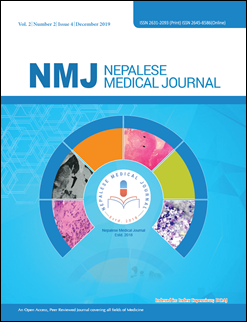Epidemiological Profile and Determinants of Tuberculosis in Urban Nepalese Population
DOI:
https://doi.org/10.3126/nmj.v2i2.25946Keywords:
Alcohol abuse; Extrapulmonary; Pulmonary; Smoking;, TuberculosisAbstract
Introduction: Tuberculosis has evolved through ages to remain a major cause of morbidity and mortality worldwide. Despite having a very successful Directly Observed Treatment, Short-course program, tuberculosis is still one of the most widespread infections in Nepal. This study was done to observe the epidemiological profile of tuberculosis patients in an urban Nepalese population.
Materials and Methods: 585 newly diagnosed cases of pulmonary and extrapulmonary tuberculosis in two tertiary level hospitals in the country were enrolled in the study during a period of 18months. A standard questionnaire was formatted and the required information was acquired with the help of interview and investigation reports.
Results: The mean age of presentation was 35.76 with a male to female ratio of 1.48:1.57% of the cases had less than primary education with 26 % being illiterates. The most commonly involved occupational group was farmers (22%) followed by students (20%) and laborers (14%). 22% of cases had a history of contact with tuberculosis in the family. 41 % were smokers and 18 % abused alcohol. Pulmonary tuberculosis comprised 68% of the total cases. The most common extrapulmonary presentation was lymph node TB (28%) followed by pleural effusion (21.5%) and tubercular meningitis (16%).
Conclusions: Young people with lower literacy levels and with a family history of tuberculosis are at increased risk of acquiring tuberculosis and community approaches for tuberculosis control should target this group to reduce the burden of the disease
Downloads
Downloads
Published
How to Cite
Issue
Section
License
This license enables reusers to distribute, remix, adapt, and build upon the material in any medium or format, so long as attribution is given to the creator. The license allows for commercial use.
Copyright on any article published by Nepalese Medical Journal is retained by the author(s).
Authors grant Nepalese Medical Journal a license to publish the article and identify itself as the original publisher.
Authors also grant any third party the right to use the article freely as long as its integrity is maintained and its original authors, citation details and publisher are identified.




